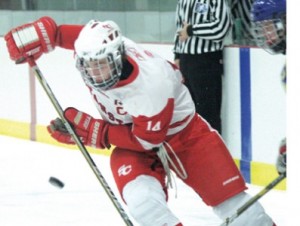A year removed from trading franchise stalwart Robyn Regehr to the Buffalo Sabres at the NHL draft, the Calgary Flames again made a deal with the Sabres by relinquishing the 14th overall pick for Buffalo’s first round pick (21st) and their 2nd round pick. In doing so, the Flames gained a second round pick as they had relinquished their own in the aforementioned Regehr trade last June. While Flames fans curiously wondered why the Flames opted to trade down, it quickly became clear once the Calgary brass stepped up to the podium and delivered a draft pick that nobody expected- selecting 17 year old center Mark Jankowski 21st overall.

Jankowski is certainly the surprise of the first round, and perhaps the draft. A lanky teenager, Jankowski closely resembles a ticket-ripper at your local movie theatre more than the high-scoring hockey player who the Flames management believe will ultimately be one of the most talented players to come out of this draft class. Standing at 6’2’’ and weighing in at 172 pounds, the teen will certainly need to fill out his frame over the coming years of his development. Fortunately, time is definitely on his side as if Jankowski had been born two days later he wouldn’t have even been eligible for this year’s draft. Also of note is that Jankowski is definitely not done growing. He has grown 4 inches in the last two years, and the Flames expect Jankowski to enter the NHL at around 6’4’’ and 215 pounds.
Statistically, Jankowski tore up the Quebec high school circuit this year. With Stanstead College, he racked up 53 goals and 93 points in just 57 games. These are terrific numbers and obviously validate the skill that Jankowski possesses, but to get a more concise and accurate read on his actual skillset he will need to play against superior competition. While it isn’t unheard of for quality players to come from this level, it is well documented that Major Junior, or even Junior A, is a higher brand of hockey and competition. Jankowski will get his first taste of increased competition next season with the Dubuque Fighting Saints of the USHL. Ironically, the Sabres used the Flames’ 14th overall pick to draft Zemgus Girgensons, a graduate of the Fighting Saints. As for Jankowski, he is also expected to play for Providence of the NCAA following his stint in Dubuque before trying to make the Flames roster in a few campaigns.
While the selection of Jankowski is intriguing due to the surprise, it also is informative in the sense that this pick solidified the current direction of the franchise. Jankowski is a high-risk investment, and even if he does pay off that will not be for another 3-5 years. The Flames are currently the 2nd oldest team in the league, and the same time frame that it takes for Jankowski to potentially begin his NHL career will likely also serve as the swan song of Jarome Iginla and Miikka Kiprusoff. With this pick, it seems that General Manager Jay Feaster seems content to once again stick with the status quo. An immediate fusion of youth is simply not coming in the degree that it needs to. This may not be because Feaster believes in this aging group but maybe because he believes this group is in need of more help than that. By the time Jankowski is NHL-ready, the current Flames team will likely be together as an aged team picture on a wall rather than on the ice.
While the immediate future of the team may seem bleak, Jankowski has the opportunity to become the best high-school draftee since T.J. Oshie of the St. Louis Blues, even if he doesn’t end up becoming the most skilled player out of the 2012 draft. Feaster and the rest of the Flames management have essentially begun to build the next era of the Calgary Flames by selecting Jankowski, finally beginning to consider the next decade of the franchise instead of the next 3 years. While it is certainly up to Jankowski to do his part and develop into a bona-fide first round success, the Flames must also do theirs by developing him and all of their future assets into players that actually pay dividends for the team. The future of the team literally depends on it.